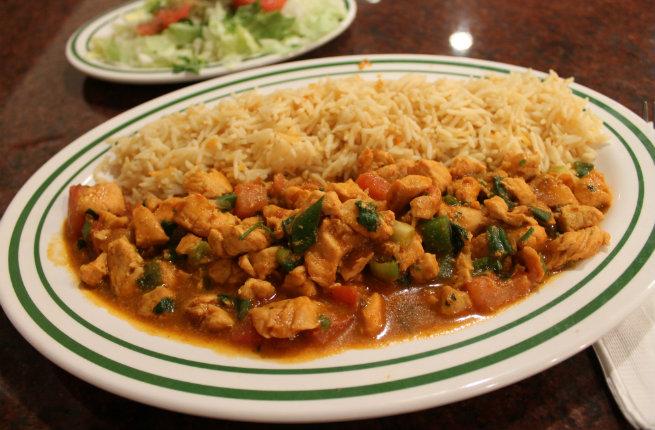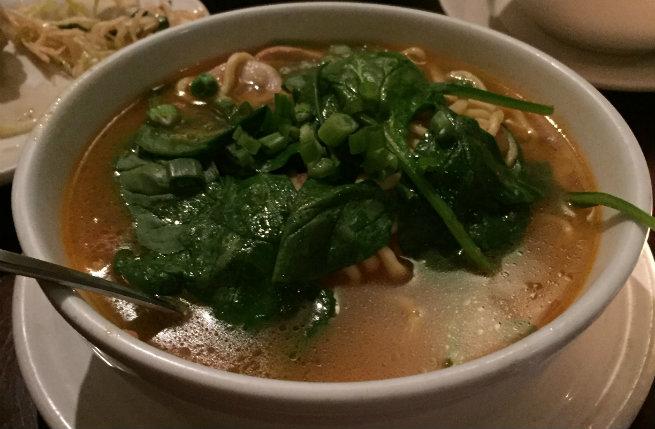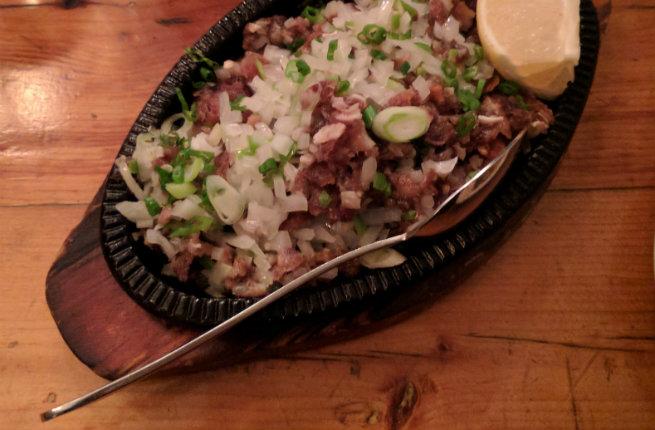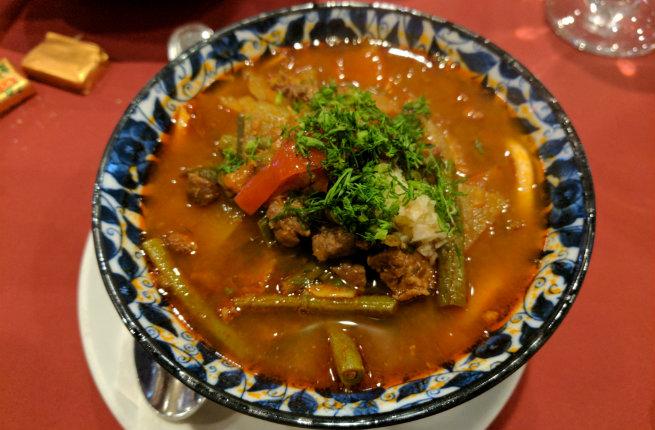One of the advantages of spending time in New York City is the ability to try different cuisines from all over the world without having to go very far (although you might spend more time than usual riding the subway). Here is a list of five less common cuisines that can be enjoyed without packing your bags.
Yemeni

Located on the southwestern tip of the Arabian Peninsula, Yemen lies at the junction of the Middle East, Africa, and Asia. Only 20 miles of water separates Yemen from the Horn of Africa, the point where the Red Sea opens up into the Indian Ocean.
In the past, many Yemeni people lived as travelers and nomads, using ancient trade routes to transport spices, incense, and oils to and from the Far East and India. Yemeni fishermen were frequent visitors along the coast of Africa, and returned home inspired by the robust spices of East Africa. Turkish and Middle Eastern dishes were introduced during the reign of the Ottoman Empire, and over the centuries, these Indian, African, and Turkish influences found their way into Yemeni cuisine to create this rich culinary tradition.
Yemeni dishes often include beef, lamb, or chicken, but in coastal regions, fish is the primary protein. Bread is used in the place of utensils, and meals are eaten communally, with each person dipping their bread in the same pot. Yemeni food can be very spicy, and chilies are used liberally. Fresh herbs and lemon may accompany a dish, and fenugreek is common, either as whole leaves or as a froth topping known as holba.
Recommended Fodor’s Video
A lamb broth soup called maraq is often served at the beginning of a meal, and although the pea-green color may not immediately entice, the soup is unexpectedly delicious. The national dish of Yemen is salta, whose exact preparation varies from place to place. Served in a steaming hot clay pot, salta is made with a slow-roasted lamb broth base and a combination of ingredients such as tomato, eggs, potato, or lamb. The salta is served topped with holba and plenty of fresh bread.
The love of chilies is most apparent in sahawiq, a salsa that is served alongside most meals, made using a combination of chilies, tomatoes, garlic, and fresh herbs. The influence of Indian cuisine is most noticeable in Zorbian chicken, which is similar in preparation to an Indian biryani, where meat is combined with basmati rice and saffron. One of the most well-known Yemeni treats is bint al-sahn, a rich, flaky bread made with honey, black sesame, and a generous amount of butter. Bint al-sahn can be eaten for breakfast, dessert, or is sometimes served at the beginning of a meal.
Where to Get It: Yemen Café in Brooklyn serves some of the city’s finest Yemeni cuisine. Be sure to self-serve the sweet, spicy black tea.
Himalayan

Himalayan cuisine refers to the entire Himalayan mountain region, which includes Nepal, Tibet, and parts of India and China. Living among the highest mountains in the world can present some logistical difficulties when it comes to sourcing food. A frigid climate and rocky soil limits the production of many crops, and in higher-altitude regions, rice and corn are not available. This location is a hindrance to imports and, combined with the fact that Nepal’s borders were opened only in the 1950s, has resulted in a cuisine that focuses primarily on locally sourced ingredients.
Himalayan food consists mostly of lean meats, root vegetables, pickled vegetables, and salads, giving it a healthier tone than similar cuisines that may use more fat or frying in cooking. It is less spicy overall than Indian food, but a wide array of condiments made of raw chilies and garlic are usually provided to turn up the heat.
Common ingredients include lentils, potatoes, tomatoes, cumin, coriander, chilies, peppers, garlic, and mustard oil. Potatoes, millet, buckwheat, and barley are tolerant to the cold and thus thrive in the higher elevations. Nepal boasts more agricultural production than other parts of the region, which is why Nepalese dishes often include rice as a staple.
Many Himalayan and Nepalese dishes are a unique combination of Chinese and Indian influences. Nepal in particular is home to over 100 different ethnic groups, each with their own culinary traditions. The most popular Himalayan food is momos. Inspired by the Chinese and brought to Nepal by Tibetan refugees, momos are small dumplings filled with meat, potatoes, or vegetables and are cooked by either steaming or sautéing.
One of the most comforting Himalayan meals is a hot noodle soup is called thukpa. Grains are ground into long noodles called thukpa or tsampa and are usually served in a broth with a combination of meat and vegetables. Dal bhat could be considered the national dish of Nepal. Based on a staple of Indian cuisine, dal bhat is made with lentils and rice (or a more available grain) and cooked to the consistency of porridge. The variations lie is in the dishes that are served on the side, which range from curry, meat, yogurt, pickles, or chutney.
Successfully combining the influences of China and India, pulao is a popular dish that consists of Chinese-style fried rice with vegetables that has been seasoned with turmeric and cumin, spices more commonly used in India. Yak is a staple of the Himalayan diet and is frequently found in a bowl of thukpa or a batch of momos. Hardy enough to survive the harsh climate, yak is widely used for its milk and meat.
Where to Get It: Café Himalaya in the East Village or one of the many Himalayan restaurants in Jackson Heights, Queens.
Georgian

The mountainous and fertile country of Georgia is nestled at a crossroads of Eastern and Western cultures. Its location along the Silk Road enabled Georgia to pick and choose their favorite influences from the Greek, Turkish, Persian, and Mongolian travelers who crisscrossed their country.
Thriving agriculture means that Georgian food includes a lot of vegetables, greens, and meats. From soups and stews in the winter to tomato salads in the summer, beets, cabbage, string beans, eggplant, and tomato are cooked in every way imaginable, accompanied by flavorful herbs like parsley, tarragon, dill, or basil.
Walnuts are a mainstay of Georgian cooking, not only for desserts but also as a thickener for soups and sauces. Dishes can be served with a variety of sauces; some can be tart or sweet, and are often made with berries, pomegranates, and tomatoes. Georgia also has a rich culture of wine production and no Georgian meal would be complete without a bottle (or two).
Georgian dishes are plentiful, but there are a few that should be not be overlooked. Khachapuri is a warm, gooey cheese bread that makes a comfortable and delicious base for a variety of toppings, such as egg, mushrooms, or scallions. Pkhali is a vegetable paste made from eggplant, spinach, leek, ground walnuts, fresh herbs, and spices, and tastes great with a khachapuri.
Khinkali are dumplings that, when expertly twisted, have too many folds to count. Similar to a Chinese soup dumpling, khinkali are stuffed with spiced meat and served boiled or steamed. Soup dumplings are notoriously difficult to eat, but the Georgians thought to make it a bit easier. A knot at the top serves as the handle, and once firmly gripped, the dumpling should be turned upside down and sprinkled with black pepper. Taking small bites on the side while slurping the broth will ensure not a drop is wasted.
Where to Get It: For classic traditional Georgian fare in a cozy atmosphere, head to Oda House in the East Village.
Filipino

Filipino cuisine is a mystery to many, and it is easy to see why. Colonialism has played a huge role in the history, culture, and most of all, the cuisine of the Philippines. The Spanish occupied the islands for more than 300 years and contributed garlic, onions, tomatoes, sweet peppers, meat and rice dishes, and decadent desserts. Later, immigrants from China brought noodle dishes, bean curds, egg rolls, and soy sauce. In the 20th century, Americans added canned and processed foods to the Filipino pantry, bringing mayonnaise, hot dogs, hamburgers, apple pies, evaporated milk, cheese, and canned tomato sauce. Nearby Malaysia managed to throw chilies and coconut milk into the mix while India slipped in a few curries, all of which culminated in the creation of one of the most far-flung fusions of cuisine in the world.
Despite those colonial times, the people of the Philippines were able to preserve some of their own traditions. Vinegar had always played the role of preservative for this balmy island nation, providing the sour taste that continues to be prevalent in many dishes. Fish sauce and fermented shrimp paste also survived to add umami to many dishes.
Spread across more than 7,000 islands, many different ethnic groups comprise the Philippines, each speaking their own dialect and cooking food in their own particular way, resulting in even more culinary variety. Filipino dishes range from simple to elaborate, but each reflects their own unique union of influences.
Many Filipino meals begin with lumpia, fried spring rolls filled with pork, mushrooms, carrots, and jicama, and dipped in sweet-sour pineapple sauce. Oxtail kare kare is braised in peanut sauce and served with vegetables and bagoong, a fermented shrimp paste. Sisig is classic Filipino street food, and due to the thoroughly chopped texture, it is hard to tell the ingredients are a combination of pig cheeks, ears, and snout flavored with lime and chilies. Pancit bihon are rice noodles served with chicken or pork, and pickled papaya accompanies deep-fried pork belly for a welcome balance of flavors.
Where to Get It: Purple Yam in Ditmas Park, Brooklyn, serves Filipino specialties and creative cocktails in a casual neighborhood setting.
Uzbek

Uzbekistan may not be the most recognizable former Soviet republic, but it undoubtedly has some of the best food. Landlocked within Central Asia, Uzbekistan was another Silk Road stopover that after centuries of trade and exposure to outsiders was able to create its own culinary traditions with the influences people liked best. A predominantly Muslim country, Uzbekistan bridges the Middle East and Far East with a little sprinkle of Russia on top.
Uzbekistan’s next-door neighbors were predominantly nomadic societies, whereas the Uzbekis lead a more settled existence. Agriculture and cattle farming laid the groundwork for their varied cuisine. Many Uzbek recipes have endured for centuries, and traditional cooking techniques and styles have been preserved over generations.
Uzbekistan’s warm climate produces abundant harvests of grains, legumes, fruits, vegetables, melons, grapes, berries, and nuts. The flavors are bold, and commonly include herbs and spices such as coriander, black cumin, dill, barberries, sesame, and basil. Many dishes are heavy on the meat, especially beef or mutton, and there is an emphasis on sour milk dishes and rich pastries.
Plov, a rice pilaf dish made with rice and meat, is regarded as Uzbekistan's signature dish. Similar to Chinese-style fried rice, the use of carrots and green onions in a plov is one of the ways Uzbek food sets itself apart from its Russian and Middle Eastern counterparts.
Another favorite is manti, a steamed beef dumpling that is also influenced by Chinese cuisine. Lamb kebabs, hummus, and babaganoush reflect distinct Middle Eastern tastes. A cucumber-radish sour yogurt salad is mixed with plenty of dill, reminiscent of Russian flavors. Lagman is lamb and vegetable noodle soup inspired by East Asia, and no Uzbek meal is complete without samsa, savory tandoor-baked pastries.
Where to Get It: The most celebrated Uzbek restaurant in the city is Nargis Café, located in Brighton Beach, Brooklyn.
Plan your foodie tour with Fodor's New York City Guide


